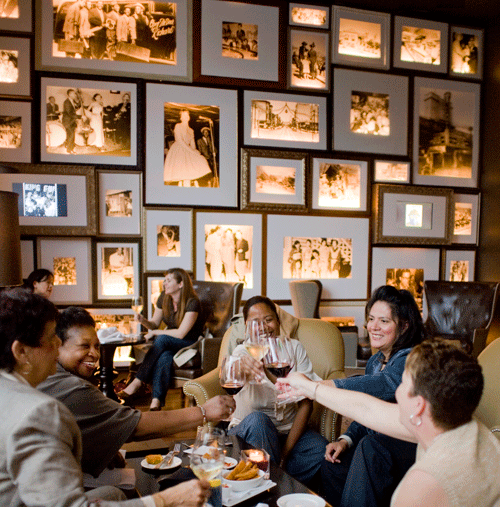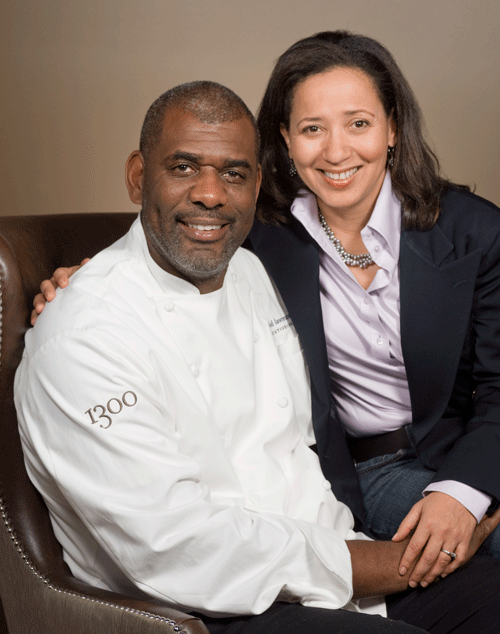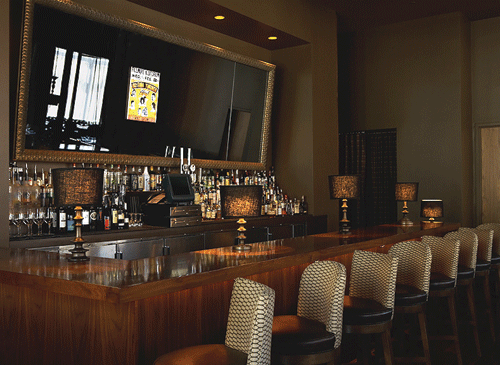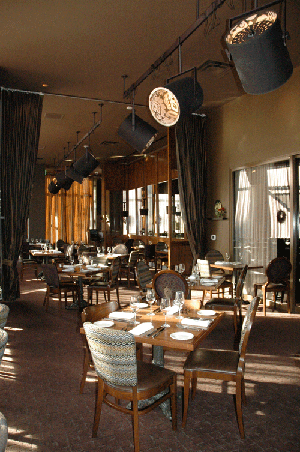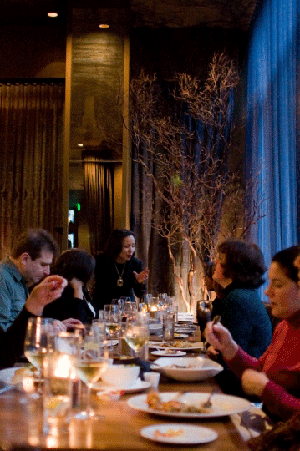HARLEM NIGHTS MEET PACIFIC HEIGHTS
A restaurant bridges the divide between upper and lower Fillmore
By BARBARA KATE REPA
David Lawrence and Monetta White are living a dream.
Their restaurant, 1300 on Fillmore, has been packed to capacity since it opened in November 2007. The food has won rave reviews. And the stylish setting attracts an enthusiastic clientele of regulars, many bringing friends.
But the spot has done something even more magical in this neighborhood: Almost overnight, it bridged the divide between upper and lower Fillmore. Their sudden success on so many levels seems to have left even the owners a bit shellshocked.
White, who grew up in the Fillmore, and Lawrence, who was born in Jamaica and raised in England, got together nearly 14 years ago. They recall their first San Francisco apartment as a place filled with food, drink and friends — and the first stirrings of the desire and confidence that led them to open their own restaurant.
“My wife gives the greatest parties. And I like to do a little bit of cooking,” Lawrence understates. “Folks came to our house because they loved what we did to entertain them. We wanted to reenact that. The ingredients for a good party are simple: good music, good food, good drink, good people — and it’s the people who are most important.”
“People warned us: You can’t cross that Mason-Dixon Line.”
Drawing on their natural hospitality and their combined talents — his as an internationally acclaimed chef most recently head of the Carnelian Room, hers as a caterer and event planner — they’ve brought an easy diversity to a neighborhood polarized for decades into north and south of Geary. “For me, it’s a matter of going back,” says White, whose mother and grandmother both grew up in the Fillmore. “People warned us: ‘You can’t cross that Mason-Dixon Line.’ They said, ‘You’re going down to lower Fillmore? Are you nuts?’ ”
While it was brave to pioneer an upscale restaurant during uncertain economic times — and especially brave on Fillmore south of Geary — White and Lawrence say the spot came looking for them. White first learned of the not-yet-built Fillmore restaurant site from an old friend, Michael Johnson. He was developing the Fillmore Heritage Center, where the restaurant is located, next door to Yoshi’s, which has helped bring a vibrant crowd of jazz and sushi fans since it opened at the end of November.
“The two of us sat around reminiscing like we were part of the early days. Then Michael said: ‘Wouldn’t it be cool to create our own legacy?’ And I got to tell you, the thought of that — the bigness — still gives me chills,” says White. “This place has done exactly what he said — and then some. I had no idea what it would do for the city — and that it would be part of the transition of this neighborhood, part of bringing together the community, culture, art. It’s more than a restaurant. And that just gives me pride jumping out of my skin.”
She adds: “The fact that the restaurant is owned by African Americans helps instill a sense of pride. Other cities have well-established African American restaurants. But San Francisco was missing that.”
“I’m on a mission to make sure people know the history of the Fillmore.”
White says one of her favorite things at 1300 is the heritage wall lining the lounge, hung with historic photos of performers and residents through the ages. Newcomers and repeat visitors alike seem riveted by it. “Hey! I was at that concert!” says one gentleman, staring close at a picture of a crooning Billie Holiday.
“I don’t care where you are or how you feel, looking at pictures breaks something down in you,” says White. “It brings you out of yourself to look at them. I went on a mission to make sure people would know the history and culture of the Fillmore,” she says. “That was part of the impetus for making the heritage wall. Now we’re helping resurrect Fillmore’s vibe again. And people are so ready for this.”
White notes there’s also a screen in the bar area that tells the story of the Fillmore through a spooling flash of pictures. “I want to change it, but after five months, people still come looking for it. So I just can’t take it down yet,” she says.
Attention to detail and a welcoming attitude sets 1300 apart and above. White and Lawrence agonized for months over the look and feel of the place, then hired the McCartan design firm to help execute their vision of a home away from home. The walls are painted in warm taupes and chocolates. The square glasses have a good heft in the hand. The women’s restrooms are outfitted with full-length mirrors and pursehooks and stocked with vases of fresh-cut flowers.
“We concerned ourselves with every detail — from the fabric on the lampshade to the colors of the chairs to the sconces on the walls,” says White. “We worked especially hard to find the wall sconces painted with flowers. People look at them and say they remind them of their grandmas. Whatever people see, they feel comfortable.”
Even the discordant notes have been carefully planned. “All of the chairs are different shapes and sizes — kind of like the way you collect them over time,” adds Lawrence. “It’s just like most homes. You get one chair and then another, but they all live together.”
“The best date place is the lounge.”
By dint of careful design, 1300 on Fillmore has four different sections: the dining room, which has a warm but formal feel; the private dining room, which has a secluded feeling all its own; the bar, for just hanging out; and the lounge, for close conversation. White and Lawrence note that the lounge makes “the best date place.” But recent guests found it suited to intimate musings of all kinds.
“This is the best place I’ve ever been broken up in,” says one young woman with spikey hair, clad in a business suit, dreamily eying the comfy leather chairs and oriental rug on the floor.
“I’ve been wanting to meet you all night,” interjects a man sporting a beret as he sees a woman stand to leave with her friend. Cards and promises are exchanged.
“I’m going to marry Ted and move to Arizona. I know you and your brother will be sad for a while. But you’ll have a new place to visit,” explains a mother to her 20-something son over martinis.
“Now that I’ve beat breast cancer, I’m gonna get myself a big pair of melons and wear plunging necklines,” says a woman with a killer smile to anyone who cares to listen.
“I could come here and sit by myself. There’s nowhere else in the city I would do that,” a tall blond woman tells her dining companion.
Those drawn into 1300’s magnetic field tend to quickly become regulars — and many of them dress for the part. It’s a spot that attracts the stylish: hats and leather and sequins chic by jowl with the denim-clad.
“What surprised me was the neighborhood response. Locals came in at once and were so open, so happy to have us here,” says Lawrence. “But want to know what I like most about this place? It’s seeing the folks come over from Pacific Heights and sit right down next to folks from the Western Addition. Their status, their culture — it doesn’t matter. Here, we’re all human beings. It’s refreshing that folks dress up to come here. That part is nice — and surprising.”
Surprising, but all part of the plan. “The space says ‘comfort,’ but people seem to come in the door with a sense of pride,” says White. “When I look back at the business plan, it actually says: ‘A place where you can be casual or dressed up’ — and it really is that kind of place.”
“We serve comfort food done well.”
And then there’s the food. Like the clientele, it echoes the north-meets-south theme: American soul food given a French twist by Lawrence’s classical training. White describes it as “comfort food done well.”
Chef Lawrence easily recalls when he first had a vision of food for the place. “Years ago, I was invited to the James Beard House with a bunch of other chefs and told, ‘We will be doing soul food.’ I knew nothing about soul food. But I made a dish of sauteed foie gras with huckleberry sauce. Everybody tasted it and said, ‘I think you’ve got something here.’ I had to agree.”
He also recalls when White first introduced him to grits a few years ago, which eventually became the base for his signature dish of barbecued shrimp with creamy grits. “I took one bite and said, ‘These are horrible: grainy and runny and lacking in substance. In England, we had cornmeal porridge, which my wife didn’t like because it was too sweet. I worked on that — savory grits — creamy but not sweet. That’s where the evolution started.”
He also recalls a culinary disaster that led to the creation of another house specialty, skillet fried chicken. “In the early days of the restaurant, we made chicken cooked in a skillet to order. But when we cooked the chicken on the bone, it sometimes looked raw. People didn’t like seeing it,” he says, wincing. “We came up with a refinement — cooking the chicken boneless — and that innovation was purely by the accident. Now it’s our most popular dish.”
“This is our dream together.”
The popularity of the place still stuns White and Lawrence, even though they have strong track records in the food and entertainment world. “David came to America 20 years ago with his own dream and he’s just getting it now,” says White. “I had a similar dream of having my own place to entertain people. This is our dream together.”
But Lawrence notes that dreams can’t be rushed: “I think the fact that we had so much experience under our belts is what made it possible to open a place of this caliber. We couldn’t have done it sooner,” he says.
“It stills feels like a dream. For four years, we’ve been saying to our friends: ‘We’re opening up a restaurant. Really. We’re opening up a restaurant.’ I think they stopped believing us,” says White. “Then when we opened, a friend came in, looked around and said: ‘Girlfriend, you’re bigtime!’ That’s when it hit me.”
And other industry bigtimers seem to be taking note. “I knew we were opening a restaurant — and a good one. But it’s better than I thought it would be. It still amazes me,” says Lawrence. “Now, our peers — people in the industry — have been coming in and giving us compliments. That fills me with pride.”
But White still plays favorites with the familiar faces past and present that make 1300 feel like home. “It’s nice to hear from industry people,” she says.
“But I get the biggest charge from people from my past who come in: my pediatrician, my old basketball coach, my calculus teacher.”
Do what you love and the rest will follow is an adage that rings true for this pair of restaurateurs. “We see more of each other now than ever before — and we’re working for ourselves, seven days a week. The truth is, we want to be here because you come in and we want to see people. It’s our daily life — and at the end of the day, we can say we worked, too.”
Their work has very much become their lives since the two gave up their Oakland home to live above the shop — in a condo upstairs in the new Fillmore Heritage Center, which rises 13 stories above the restaurant. “Other people are amazed. They say to David. ‘You get to see your wife every night, all dressed up, in this beautiful place.’ We live right upstairs and we try to have dinner together every night before we come down,” says White.
“Now we have to work on balance,” says Lawrence. “Oh. Look at that little spot on the ceiling,” he says, gazing upward. “It hasn’t been painted.”
“It’s been painted, just not doublepainted,” says White. “We have to get that done. And a few other things …”




